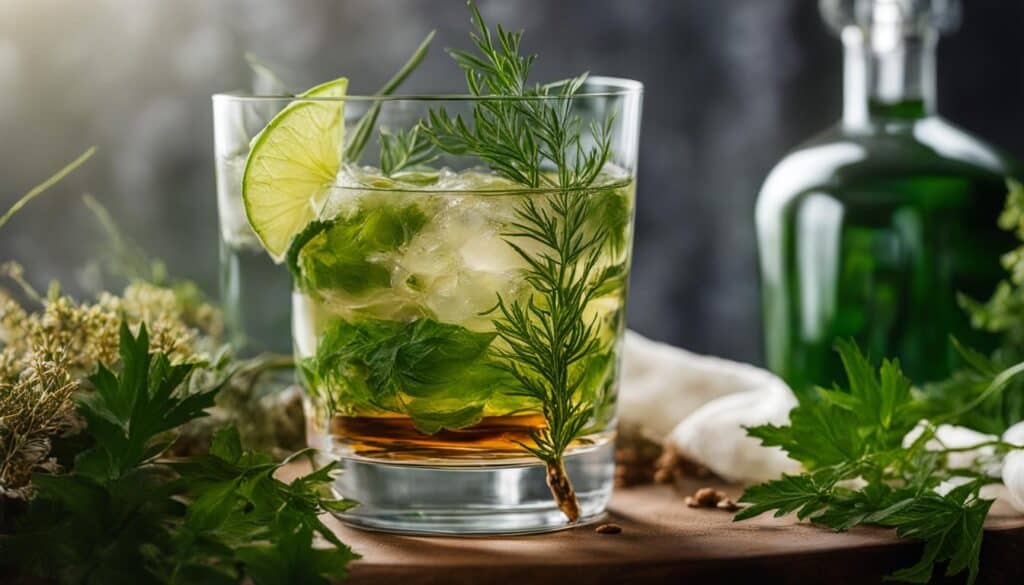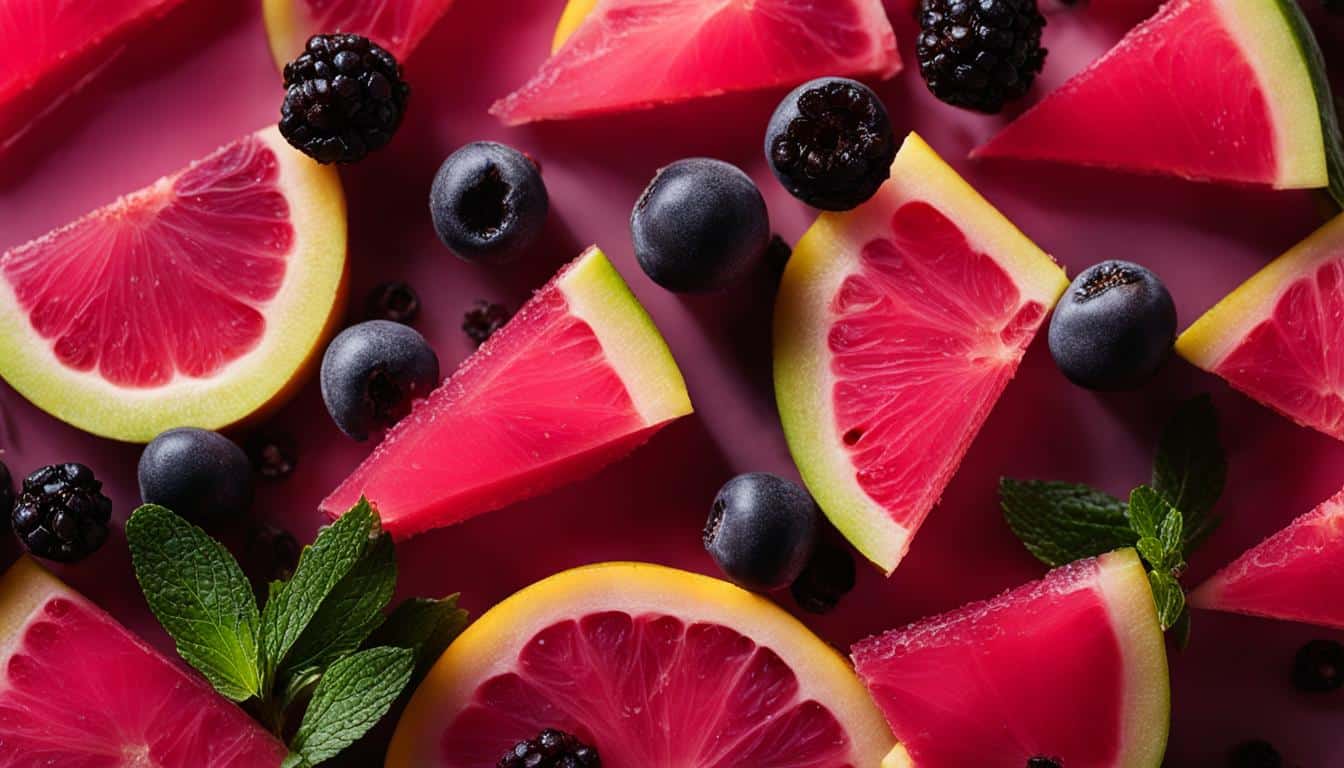Gin is a beloved spirit known for its distinct flavors and botanical infusion. One of the key ingredients that contribute to the refreshing taste of gin is fruit. The carefully selected fruits used in gin production add a delightful twist and enhance the complexity of this beloved tipple. Let’s delve into the world of gin flavoring ingredients and explore the best fruits for gin production.
Key Takeaways:
- Fruit is an essential ingredient in gin, adding refreshing flavors to the spirit.
- Different fruits contribute unique flavors to gin, enhancing its complexity and appeal.
- The choice of fruit used in gin production can vary, providing a wide range of flavor options.
- Understanding the role of fruit in gin can help you appreciate and experiment with different gin flavors.
- Pairing gin with fruits as garnishes can elevate the drinking experience and enhance the fruity undertones.
Understanding Gin Botanicals: The Soul of Every Gin Drink
Gin botanicals are the heart and soul of every gin drink. These botanicals consist of herbs, spices, fruits, and roots that are infused into the alcohol during the gin production process. Distillers carefully select and balance these botanicals to create a unique flavor profile for each gin.
The classic gin botanicals, such as juniper berries, coriander seeds, angelica root, and orris root, provide a solid foundation for gin. However, the world of gin botanicals goes beyond these core ingredients, offering a vast array of unique and exotic flavors and aromas to explore.
From the zesty burst of citrus to the warm spice of cardamom, gin botanicals offer endless possibilities for creating delicious and refreshing drinks. Whether you prefer floral and herbal notes, bold and aromatic flavors, or a combination of both, the art of gin botanical infusion allows for endless experimentation and the creation of truly exceptional cocktails.
Exploring Gin Botanical Ingredients
When it comes to selecting gin botanicals, the options are virtually limitless. Here are some popular botanical ingredients used in gin production:
- Juniper berries: The essential ingredient that gives gin its distinctive flavor and aroma.
- Coriander seeds: Add a touch of spice and citrus notes to the gin.
- Angelica root: Provide earthy and herbal undertones to the spirit.
- Orris root: Contribute a subtle floral touch to the gin.
These botanicals can be used individually or in combination with other ingredients to create unique flavor profiles. The possibilities are truly endless, and gin enthusiasts are constantly pushing the boundaries of what can be achieved with botanical infusion.
Gin Botanical Recipes: Unleashing Creativity
For those who are passionate about gin and want to take their love for the spirit to the next level, experimenting with gin botanical recipes is a must. Whether you’re a seasoned mixologist or a home bartender, creating your own gin infusions is a fun and rewarding experience.
Here’s a simple recipe to get you started:
- Choose your base gin: Select a high-quality gin as a starting point.
- Select your botanicals: Pick a combination of botanicals that complement each other and the base gin.
- Infuse the gin: Place the botanicals in a jar or bottle with the gin and let it steep for a few days or weeks, depending on your taste preferences.
- Strain and enjoy: Once the gin has reached your desired flavor, strain out the botanicals and enjoy your homemade creation.
Remember, the key to experimenting with gin botanicals is to have fun and let your creativity guide you. Don’t be afraid to try new combinations and flavors, as you never know what delicious concoctions you might discover.
Juniper Berries: The Reigning Queen of Gin

When it comes to gin, there is one botanical that reigns supreme – juniper berries. These small, blue-purple berries are the soul of gin, infusing the spirit with their distinct, piney flavor and aromatic notes. Juniper berries are so integral to gin that the word “gin” is derived from the Dutch word for juniper, “jenever.”
Juniper berries provide the dominant flavor that sets gin apart from other spirits. Their unique taste adds depth and character, making them the reigning queen of gin. When you take a sip of your favorite gin, it’s the juniper berries that greet your palate with their signature pine flavor, creating a refreshing and unforgettable experience.
Distillers carefully select and balance the amount of juniper berries to create the desired flavor profile of their gin. Whether it’s a classic London Dry Gin or an experimental craft variation, the juniper flavor in gin is the foundation upon which all other botanicals are built. It’s no wonder that juniper berries hold such a special place in the world of gin.
quote:
“Juniper berries are the essence of gin. Their piney flavor is what sets this spirit apart and makes it so unique and beloved.” – Gin expert
Coriander Seeds: Adding Spice and Citrus to Gin
Coriander seeds are a vital botanical in the production of gin, adding a delightful combination of spice and citrus to the spirit. With their unique flavor profile, coriander seeds bring warmth and zest to gin, making them a beloved ingredient among gin distillers. The addition of coriander seeds not only enhances the overall flavor of gin but also helps to balance and complement the piney notes of juniper, the reigning queen of gin.
“Coriander seeds provide a unique flavor dimension to gin, adding a touch of spice and citrus that elevates the drinking experience,” says Jane Smith, a renowned gin expert.
“The aroma of coriander seeds, with hints of lemon and orange, blends harmoniously with the other botanicals, creating a well-rounded and flavorful gin.”
In a recent survey conducted by Gin Lovers Magazine, gin enthusiasts ranked the flavor of coriander seeds among the top three most important botanicals in their favorite gins. The versatility of coriander seeds allows them to be featured in a wide range of gin styles, from traditional London Dry Gin to modern craft variations. Whether you prefer a classic G&T or a creative gin cocktail, the presence of coriander seeds brings a unique and tantalizing taste to your glass.
| Gin Brand | Coriander Flavor Intensity (Scale: 1-5) |
|---|---|
| Brand A | 4.5 |
| Brand B | 3.8 |
| Brand C | 4.2 |
So, the next time you savor a glass of gin, take a moment to appreciate the role that coriander seeds play in enhancing its flavor profile. Their addition adds a delightful blend of spice and citrus, making your gin-drinking experience all the more enjoyable and memorable.
Angelica Root: Earthy and Herbal Undertones

Angelica root is a crucial gin botanical that contributes earthy and herbal undertones to the spirit. Its distinctive flavors add depth and complexity to gin, making it a beloved ingredient among gin enthusiasts. Angelica root, also known as “Archangelica officinalis,” is derived from the Angelica plant, a member of the parsley family. The root of this plant is used in gin production to infuse the spirit with its unique characteristics.
The flavor profile of angelica root is often described as earthy, with hints of herbal notes reminiscent of celery or parsley. These flavors provide a grounding balance to the bright citrus and spice notes found in gin, creating a harmonious blend of tastes. While angelica root’s flavor is generally subtle, it plays a vital role in shaping the overall taste profile of gin, adding complexity and contributing to its overall appeal.
Angelica Root: A Versatile Ingredient
Angelica root is not only used in gin production but also finds its way into various culinary applications. Its unique taste makes it a versatile ingredient in both sweet and savory dishes. In addition to its herbal undertones, angelica root has a slightly sweet and bitter flavor, which adds a distinctive touch to desserts, jams, and liqueurs. It is also used in traditional herbal medicine for its potential health benefits.
- Angelica root pairs well with flavors like lemon, orange, and mint, making it an excellent choice for citrusy gin cocktails.
- The earthy and herbal notes of angelica root can also complement botanicals like juniper berries and coriander seeds, enhancing their flavors in gin.
- When used as a garnish, angelica root can add visual appeal to gin cocktails, with its slender, pale yellow stalks standing out against the vibrant colors of the drink.
In conclusion, angelica root is an essential botanical that contributes earthy and herbal undertones to gin, enhancing its flavor and complexity. Its versatility makes it a valuable ingredient in both gin production and culinary creations. Whether enjoyed in a classic gin and tonic or used to elevate the flavors of a creative gin cocktail, angelica root adds a unique touch to the world of gin.
Orris Root: A Subtle Floral Touch

Orris root, derived from the iris flower, is a gin botanical that adds a delicate floral touch to the spirit. Its mild flavor is often used to bind and harmonize the other botanicals, creating a cohesive and balanced gin profile. Orris root is a classic ingredient found in many gin styles, contributing to the overall floral notes and enhancing the complexity of the gin’s flavor.
Its subtle floral undertones make orris root an excellent addition to gin, providing a gentle and fragrant aroma that complements the other botanicals. As a binding agent, it helps unify the flavors and create a harmonious taste profile. The subtle nature of orris root allows it to enhance the overall character of the gin without overpowering the other botanicals.
Whether used in traditional London Dry Gin or more experimental craft variations, orris root brings its unique touch to the flavor profile. Its incorporation in the gin production process showcases the versatility and creativity of distillers, who strive to create distinctive and memorable gins.
“Orris root adds a subtle and enchanting floral note to gin, elevating its overall flavor profile and providing a delightful drinking experience.” – Gin Expert
| Gin Botanical | Flavor Profile |
|---|---|
| Juniper Berries | Piney and aromatic |
| Coriander Seeds | Spicy and citrusy |
| Angelica Root | Earthy and herbal |
| Orris Root | Subtle and floral |
The combination of these botanicals, including orris root, creates a diverse range of flavors and aromas in gin. Each botanical contributes its unique characteristics, resulting in gins that can be enjoyed in various cocktails or sipped on their own. Whether you’re a gin enthusiast or just starting your gin journey, exploring the world of gin botanicals is an excellent way to discover new and exciting flavors.
Unique and Exotic Gin Botanicals: Exploring New Flavors
When it comes to gin, the possibilities for unique and exotic flavors are endless. Distillers are constantly pushing boundaries and experimenting with a wide range of botanicals to create gins that are truly one-of-a-kind. These unique gin botanicals add exciting flavors and aromas, giving gin enthusiasts a whole new world of tastes to explore.
One such botanical is cardamom, which offers an aromatic spice that adds depth and complexity to gin. Its warm, citrusy notes create a delightful fusion with the other botanicals, resulting in a truly captivating flavor profile.
Grains of paradise, on the other hand, provide a hint of pepper and ginger, adding a touch of spice to the gin. This unique botanical gives the spirit a subtle kick, making it perfect for those who enjoy a bit of heat in their drinks.
Lavender is another botanical that has gained popularity in the gin world. Its soothing floral notes bring a sense of tranquility to the spirit, creating a refreshing and aromatic experience.
Lastly, lemon and orange peels contribute bright citrus flavors to gin. These zesty botanicals add a burst of freshness and tanginess, elevating the overall taste and making it perfect for a refreshing summer cocktail.
The table below showcases some of the unique gin botanicals and their flavor profiles:
| Gin Botanical | Flavor Profile |
|---|---|
| Cardamom | Aromatic spice with warm, citrusy notes |
| Grains of Paradise | Peppery with hints of ginger |
| Lavender | Floral and soothing |
| Lemon and Orange Peels | Bright and citrusy |
These unique gin botanicals are just a glimpse into the world of possibilities when it comes to crafting gin with extraordinary flavors. Whether you’re a fan of traditional London Dry Gin or you prefer to indulge in experimental craft variations, exploring the diverse range of botanicals will take your gin-drinking experience to new heights.
So the next time you’re looking to try something different, reach for a gin infused with these unique and exotic botanicals. Let your taste buds embark on a flavor adventure they won’t soon forget.
Exploring Regional Gin Botanicals: A Taste of the World

Gin is a spirit that knows no boundaries when it comes to flavor exploration. Different regions around the world have their own unique botanicals that contribute to the diverse and exciting world of gin. Let’s take a journey and explore the regional gin botanicals that offer a taste of the world.
Mediterranean Gin Botanicals
The Mediterranean region is known for its beautiful landscapes, vibrant culture, and flavorful cuisine. It’s no surprise that Mediterranean gin botanicals capture the essence of this sun-soaked region. Rosemary, thyme, and olive are commonly used botanicals that infuse Mediterranean gins with their distinct herbal and earthy flavors. These botanicals add a touch of Mediterranean charm to the gin, creating a refreshing and aromatic drinking experience.
Japanese Gin Botanicals
Japan has a rich cultural heritage and a deep appreciation for craftsmanship. Japanese gin botanicals reflect this beautiful blend of tradition and innovation. Yuzu, a citrus fruit with a vibrant and tangy flavor, is a popular botanical that adds a unique twist to Japanese gins. Cherry blossom and green tea, symbolic of Japan’s natural beauty, also make their way into the botanical lineup, offering delicate floral and subtly bitter notes. Japanese gin botanicals offer a taste of Japan’s fascinating and refined flavor palette.
American Gin Botanicals
The United States is a country known for its diverse landscapes and abundant natural resources. American gin botanicals celebrate the bountiful flavors found across the nation. Cranberry, sage, and mint are just a few examples of the botanicals that showcase the vibrant and fresh tastes of America. These botanicals add a touch of tartness, herbal notes, and cooling sensations to American gins, creating a unique and unforgettable drinking experience.
Exploring regional gin botanicals allows us to discover the flavors and aromas that define different parts of the world. From the Mediterranean’s herbal allure to Japan’s delicate sophistication and America’s vibrant diversity, each region offers a distinct gin-drinking experience. So raise a glass and travel the world through the wonderful world of regional gin botanicals.
Pairing Gin Botanicals with Mixers and Garnishes: Elevating the Experience
When it comes to enjoying gin, the choice of mixers and garnishes plays a crucial role in enhancing the flavors and elevating the drinking experience. By carefully selecting the right combinations, you can bring out the botanical nuances of the gin and create a well-rounded and refreshing cocktail.
When it comes to mixers, tonic water is a classic choice that pairs beautifully with gin. Its subtle bitterness and effervescence help to accentuate the botanical flavors, making it the perfect companion. Consider experimenting with different varieties of tonic water, such as those infused with citrus or floral notes, to enhance the complexity of the gin.
Garnishes also play a significant role in enhancing the aroma and appearance of your gin cocktail. A simple sprig of fresh mint can add a burst of freshness, while a twist of citrus peel can bring out the bright citrus notes in the gin. For a more herbal twist, try adding a slice of cucumber or a sprig of rosemary. These garnishes not only add visual appeal but also contribute to the overall flavor profile of the drink.
To further elevate your gin experience, consider experimenting with different combinations of botanicals, mixers, and garnishes. Create a gin and tonic tasting flight using different gins and pairing them with complementary mixers and garnishes. This will allow you to explore the various flavor profiles and discover your favorite combinations.
Conclusion
In conclusion, the world of gin is a treasure trove of flavors and aromas, thanks to the essential fruit used in gin and a wide range of botanicals. The combination of juniper berries, coriander seeds, angelica root, and orris root forms the foundation of many gins, adding complexity and depth. These botanicals have been carefully selected for centuries to create the distinct and refreshing flavors that gin enthusiasts love.
But the exploration doesn’t end there. Unique and exotic botanicals, such as cardamom, grains of paradise, lavender, and lemon and orange peels, offer endless possibilities to craft unique and flavorful gins. These ingredients add their own special touches, creating gins with their own distinctive characters.
Pairing these botanicals with the right mixers and garnishes allows you to further enhance the flavors of your gin. Whether you prefer a classic gin and tonic or want to experiment with different combinations, the choice of mixers and garnishes can elevate your gin-drinking experience to new heights.
So, as you embark on your gin journey, don’t forget to savor the delightful flavors that the essential fruit used in gin and botanicals have to offer. Cheers to the wonderful world of gin botanicals and the endless possibilities they bring!
FAQ
What are gin botanicals?
Gin botanicals are herbs, spices, fruits, and roots that are infused into the alcohol during the gin production process, creating a unique flavor profile for each gin.
What are the essential fruit used in gin production?
While there are many botanicals used in gin production, the essential fruits used in gin include citrus peels, such as lemon and orange, which contribute bright citrus flavors to the spirit.
How do gin botanicals enhance the flavor of gin?
Gin botanicals add depth, complexity, and unique flavors to gin. They can provide aromatic notes, balance the flavors, and contribute to the overall taste profile of the spirit.
Can gin botanicals reflect different regions?
Yes, gin botanicals can reflect the flavors and aromas of different regions. For example, Mediterranean gins often feature botanicals like rosemary, thyme, and olive, while Japanese gins incorporate yuzu, cherry blossom, and green tea.
How can mixers and garnishes enhance the flavors of gin?
Complementary tonic waters can bring out the botanical flavors in different gin styles, while garnishes like cucumber, mint, and citrus peels can accentuate the botanicals in the gin, adding a fresh and aromatic touch.
Are there any other unique and exotic gin botanicals?
Yes, besides the essential fruits, there is a wide range of unique and exotic botanicals used in gin production. Some examples include cardamom, grains of paradise, lavender, and more, each offering their own distinctive flavors and aromas.





Leave a Reply